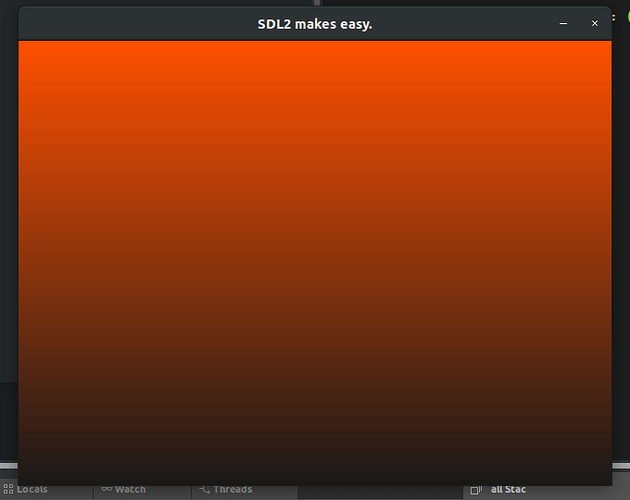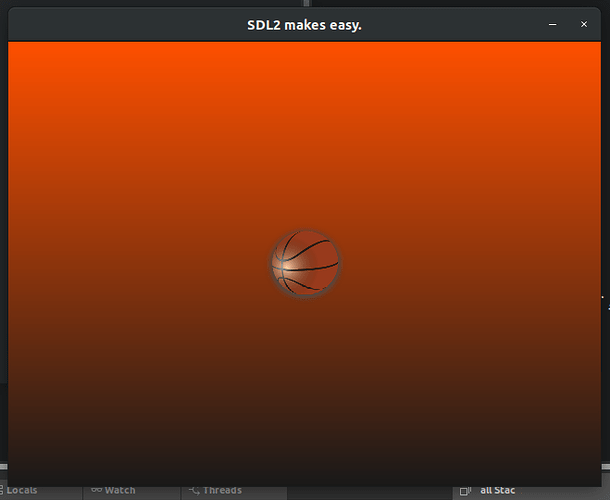Tried to make a bit verbose, and with command line parameter (and a small help text). Hope it helps.
#include <SDL2/SDL.h>
#include <math.h>
#include <stdio.h>
const int SCREEN_WIDTH = 640;
const int SCREEN_HEIGHT = 480;
void drawHorizontalGradientBox(SDL_Renderer * renderer,
const int x, const int y, const int w, const int h, const float steps,
const SDL_Color c1, const SDL_Color c2, const int fill)
{
/* Acumulator initial position */
float yt = y;
float rt = c1.r;
float gt = c1.g;
float bt = c1.b;
float at = c1.a;
/* Changes in each attribute */
float ys = h/steps;
float rs = (c2.r - c1.r)/steps;
float gs = (c2.g - c1.g)/steps;
float bs = (c2.b - c1.b)/steps;
float as = (c2.a - c1.a)/steps;
for(int i = 0; i < steps ; i++)
{
/* Create an horizontal rectangle sliced by the number of steps */
SDL_Rect rect = { x, yt, w, ys+1 };
/* Sets the rectangle color based on iteration */
SDL_SetRenderDrawColor(renderer, rt, gt, bt, at);
/* Paint it or coverit*/
if(fill)
SDL_RenderFillRect(renderer, &rect);
else
SDL_RenderDrawRect(renderer, &rect);
/* Update colors and positions */
yt += ys;
rt += rs;
gt += gs;
bt += bs;
at += as;
}
}
int main(int argc, char *argv[])
{
SDL_Init(SDL_INIT_VIDEO);
SDL_Window * window = SDL_CreateWindow("Gradients",
SDL_WINDOWPOS_UNDEFINED, SDL_WINDOWPOS_UNDEFINED,
SCREEN_WIDTH, SCREEN_HEIGHT, SDL_WINDOW_SHOWN);
SDL_Renderer * renderer = SDL_CreateRenderer(window, -1, SDL_RENDERER_ACCELERATED);
SDL_Event event;
int x = SCREEN_WIDTH / 4;
int y = SCREEN_HEIGHT / 4;
int w = SCREEN_WIDTH / 2;
int h = SCREEN_HEIGHT / 2;
int s = 10;
SDL_Color c1 = (SDL_Color) { 0, 0, 0, 255 };
SDL_Color c2 = (SDL_Color) { 255, 255, 255, 255 };
int fill = 0;
if(argc > 1 && argc != 15)
{
printf("%s x y w h s r1 g1 b1 a1 r2 g2 b2 a2 fill (all integers)\n", argv[0]);
printf("Examples:\n\n");
printf("./horizontal_gradient 120 120 200 200 50 255 200 200 255 255 10 10 255 1\n");
printf("./horizontal_gradient 120 120 200 200 20 0 255 200 255 255 10 10 255 0\n");
printf("\n");
exit(1);
}
else if(argc > 1 && argc == 15)
{
x = atoi(argv[1]);
y = atoi(argv[2]);
w = atoi(argv[3]);
h = atoi(argv[4]);
s = atoi(argv[5]);
c1 = (SDL_Color) {
atoi(argv[6]),
atoi(argv[7]),
atoi(argv[8]),
atoi(argv[9])
};
c2 = (SDL_Color) {
atoi(argv[10]),
atoi(argv[11]),
atoi(argv[12]),
atoi(argv[13])
};
fill = atoi(argv[14]);
}
int quit = 0;
SDL_Rect contour = { x-1, y-1, w+2, h+2};
while(!quit)
{
while(SDL_PollEvent(&event) != 0)
if(event.type == SDL_QUIT)
quit = 1;
// Draw a ugly background
SDL_SetRenderDrawColor(renderer, 100, 100, 100, 10);
SDL_RenderClear(renderer);
drawHorizontalGradientBox(renderer, x, y, w, h, s, c1, c2, fill);
// Draw a contour for sake of debug...
SDL_SetRenderDrawColor(renderer, 0, 255, 0, 50);
SDL_RenderDrawRect(renderer, &contour);
SDL_RenderPresent(renderer);
SDL_Delay(10);
}
SDL_DestroyRenderer(renderer);
SDL_DestroyWindow(window);
SDL_Quit();
}

